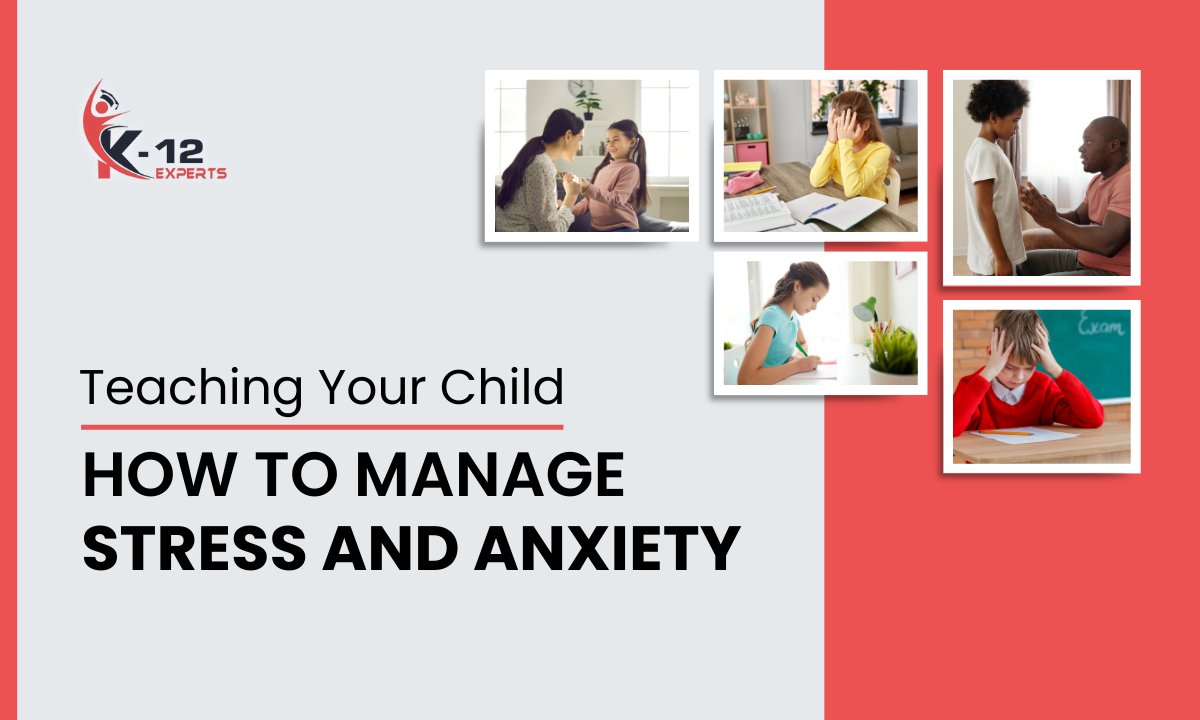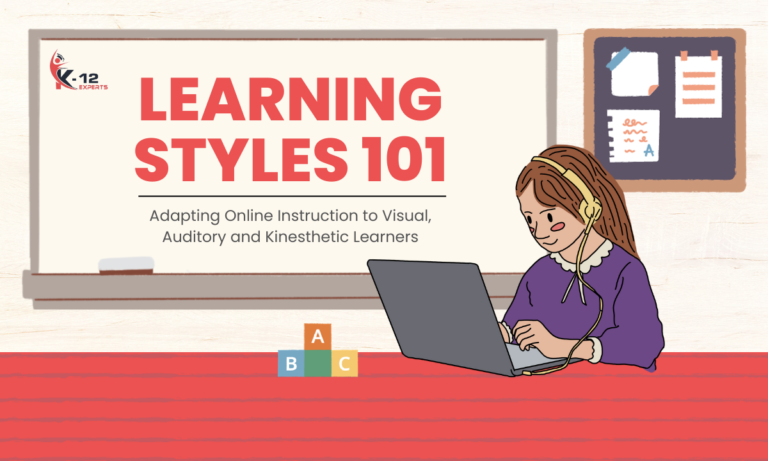Teaching your child to handle stress and anxiety is crucial as you guide them through childhood. If you see your child feeling overwhelmed or anxious, acting quickly is essential. Using clear strategies can help immensely.
For example, keeping a consistent daily schedule provides stability, talking openly with your child about their feelings shows support, and teaching them relaxation methods like deep breathing or yoga can calm their nerves. These tools assist them now and prepare them for adult challenges.
Remember, ensuring your child’s mental health is as important as their physical health.
Understanding Child Stress and Anxiety
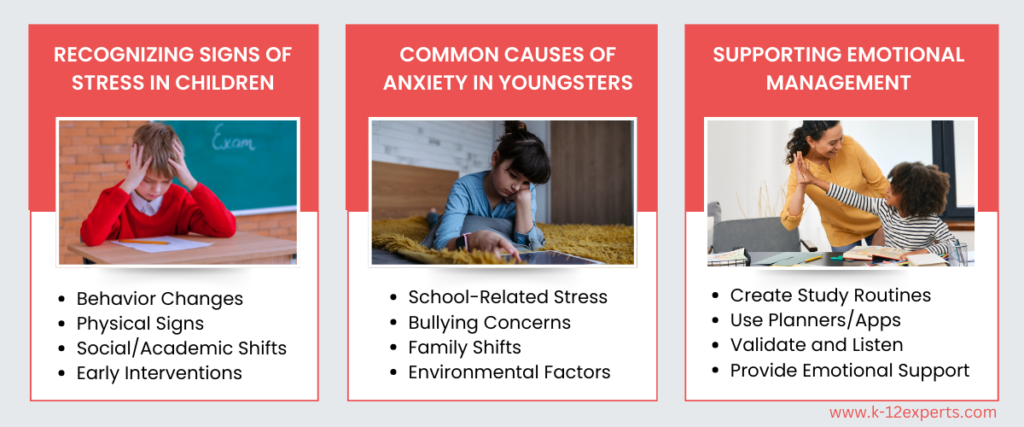
It’s important to notice when your child is stressed. They mightn’t always show it clearly.
Children can feel anxious due to changes like a new school routine or because of homework and tests. Knowing what makes your child anxious can help them handle these situations better.
For example, if your child worries about a test, you can help by setting a regular daily study time. This can make preparing less stressful.
Tools like a simple planner or a study app can also help them keep track of assignments and test dates, making their schoolwork feel more manageable.
Recognizing Signs of Stress in Children
Here are some common signs to look for if your child is stressed:
| Signs of Stress | Examples |
| Behavioral Changes | Eating less, trouble sleeping, increased attachment, mood swings, thumb-sucking |
| Physical Symptoms | Frequent headaches or stomachaches |
| Social or Academic Changes | Falling grades, difficulty with friends |
By observing these changes early, you can intervene before they feel overwhelmed. You’re their biggest support during difficult times.
Common Causes of Anxiety in Youngsters
Identifying the causes of your child’s anxiety can help reduce their stress. Many children feel stressed by school issues like tests or being bullied.
Anxiety can stem from both environmental factors and genetics. Recognizing these causes and validating your child’s feelings provides crucial support, helping them manage their emotions more effectively.
Changes at home, such as parents getting divorced or welcoming a new brother or sister, can also lead to anxiety. Additionally, hearing about global events from news or adult talks might worry them.
It’s important to know that both the environment and genes play roles in anxiety. By understanding what causes your child’s anxiety, you can support them better.
Listening to them and acknowledging their feelings is crucial. This support helps them manage their emotions more effectively.
Foundational Strategies to Address Anxiety
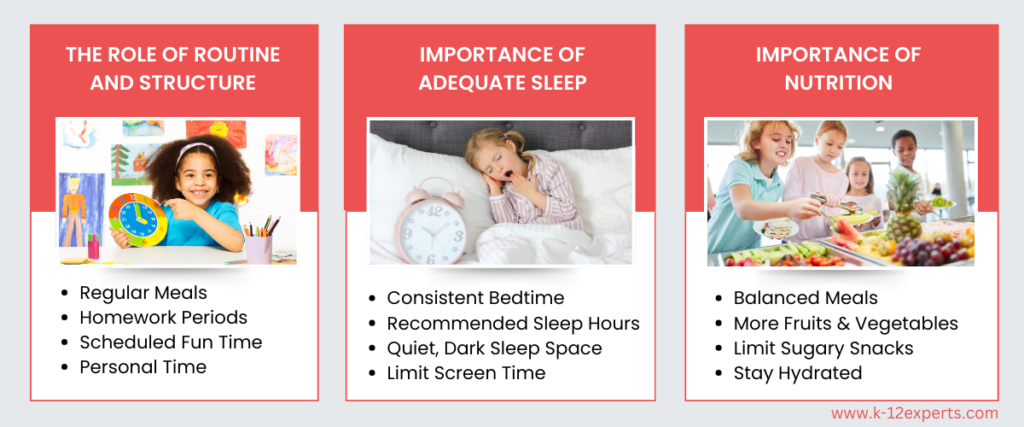
When helping your child deal with anxiety, it’s crucial to have a regular daily schedule. This routine gives them a feeling of safety, which is very important.
Ensure they sleep enough and eat healthy meals, as both significantly affect their stress. By focusing on these basic steps, you’re not just taking care of their health; you’re also equipping yourself to support them through tough times better.
For example, setting a bedtime at the same time each night helps your child wind down and prepares their body for rest.
For nutrition, consider incorporating foods known to reduce stress, such as yogurt, nuts, and fruits. These small, consistent actions build a stable environment for your child, helping to ease their anxiety.
The Role of Routine and Structure
A predictable routine can significantly lower your child’s anxiety by making their day more structured. Setting regular times for meals, homework, and play allows them to know what to expect, reducing uncertainty and stress.
Essential elements of a good routine include:
- Regular meal times
- Designated homework periods
- Scheduled time for fun activities
- Time set aside for personal activities
- A consistent bedtime
While maintaining structure, small variations (e.g., shifting dinner by 30 minutes) can help your child adapt to changes, enhancing their ability to cope with life’s unpredictability. Tools like visual schedules or apps like “Time Timer” can further support them in following routines.
Importance of Adequate Sleep and Nutrition
Along with a consistent routine, ensuring your child gets enough sleep and eats nutritious meals is essential for managing stress and anxiety.
Here’s a breakdown:
Sleep Guidelines:
- Set a fixed bedtime to help regulate their sleep cycle.
- Make sure they get the recommended amount of sleep every night.
- Keep their sleeping environment quiet and dark to promote better sleep.
- Reduce screen time before bed to improve sleep quality.
- If your child is younger or seems extra tired, short naps during the day can be beneficial.
Nutrition Advice:
- Serve balanced meals that include a variety of food groups.
- Incorporate a lot of fruits and vegetables into their diet.
- Avoid too many sugary snacks and drinks.
- Stick to regular times for meals to help their body stay in a rhythm.
- Drinking plenty of water is crucial; it helps with overall health.
Why This Matters: Adequate sleep and proper nutrition improve mood, focus, and cognitive function, all crucial for managing stress and anxiety effectively.
Communication Techniques That Support Your Child
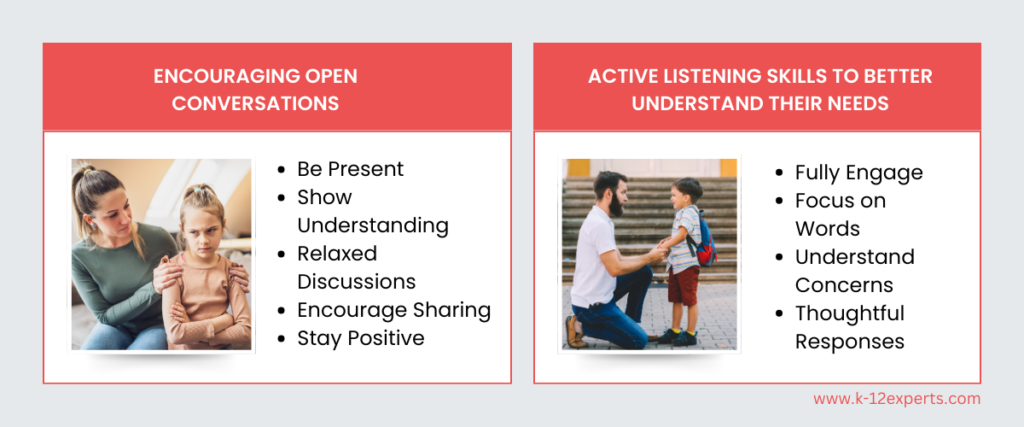
Open discussions are crucial when your child faces stress or anxiety. Active listening helps you understand their concerns, strengthens your bond, and encourages them to share more openly.
For example, if they’re worried about a test, listen attentively, offer reassurance, and provide practical study strategies. Such supportive conversations can ease their anxiety.
Encouraging Open Conversations
Creating an environment where your child feels safe to express their concerns is essential for reducing stress.
Here are some effective steps to create such a space:
- Be present: Dedicate daily time for conversations, even if brief.
- Show understanding: Recognize and validate their emotions.
- Keep discussions relaxed: Talk during routine activities like meals or drives.
- Promote sharing: Assure them that it’s safe to express their feelings.
- Maintain a positive outlook: Concentrate on constructive solutions and positive aspects.
Asking simple questions, like “What was the best part of your day?” during dinner can encourage them to share more freely.
Active Listening Skills to Better Understand Their Needs
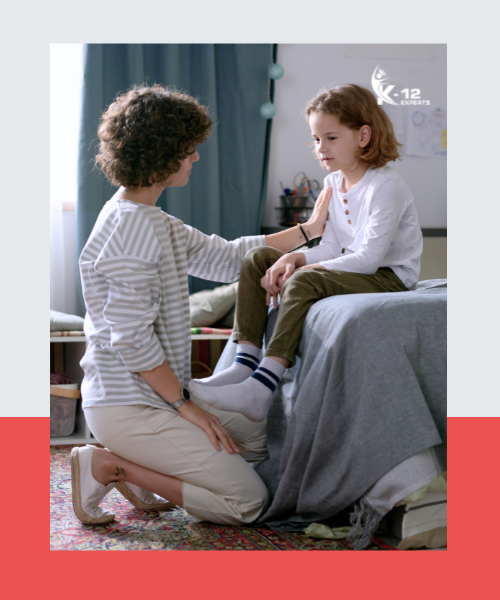
Active listening involves fully engaging with your child to understand their emotions. By focusing on their words, grasping their concerns, and responding thoughtfully, you can uncover the root causes of their anxiety.
Remembering details from past conversations reinforces that they are heard and appreciated, making them feel more comfortable sharing their feelings.
Relaxation and Mindfulness Exercises for Children
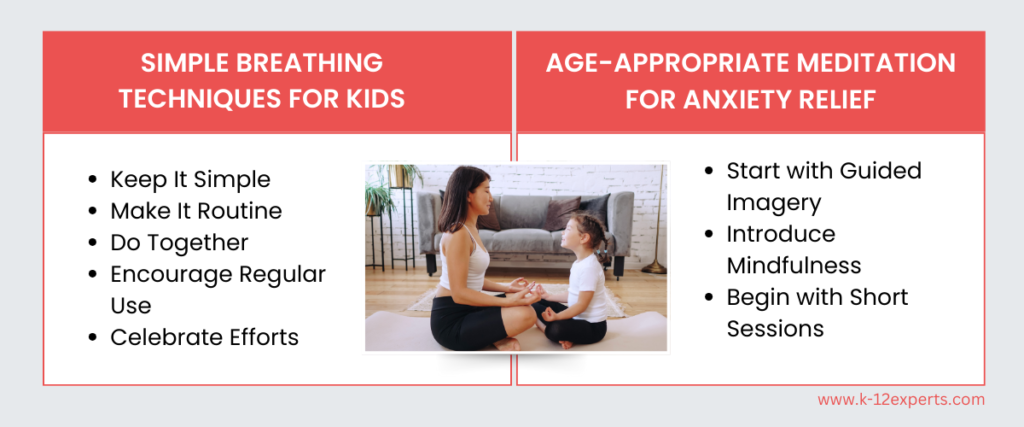
Introducing your child to simple breathing exercises can significantly reduce their stress.
Just a few minutes each day of age-appropriate meditation can help manage anxiety by promoting emotional control and improving overall health.
Start with simple techniques like counting breaths or visualizing a calm place to build a calming routine.
Simple Breathing Techniques for Kids
Teaching easy breathing exercises can help children manage anxiety. Methods like belly breathing or the 4-7-8 technique are especially effective.
Here’s a straightforward way to help them:
- Keep it simple: Teach them to breathe in deeply through their nose, making their belly rise, then slowly exhale through their mouth.
- Make it routine: Incorporate it into daily activities, like mornings or before bed.
- Do it together: Join them to show it’s normal and helpful.
- Encourage regular use: Remind them to use the technique whenever they feel anxious.
- Celebrate their efforts: Praise them when they use these techniques to reinforce their practice.
Age-Appropriate Meditation for Anxiety Relief

Meditation can complement breathing exercises to ease anxiety further.
Start with guided imagery, having your child imagine peaceful settings like a forest or beach to calm their mind.
Mindfulness is another effective technique, teaching them to focus on the present and observe their thoughts without judgment.
Begin with short sessions and gradually increase the time as they get more comfortable managing their emotions.
Building a Supportive Home Environment
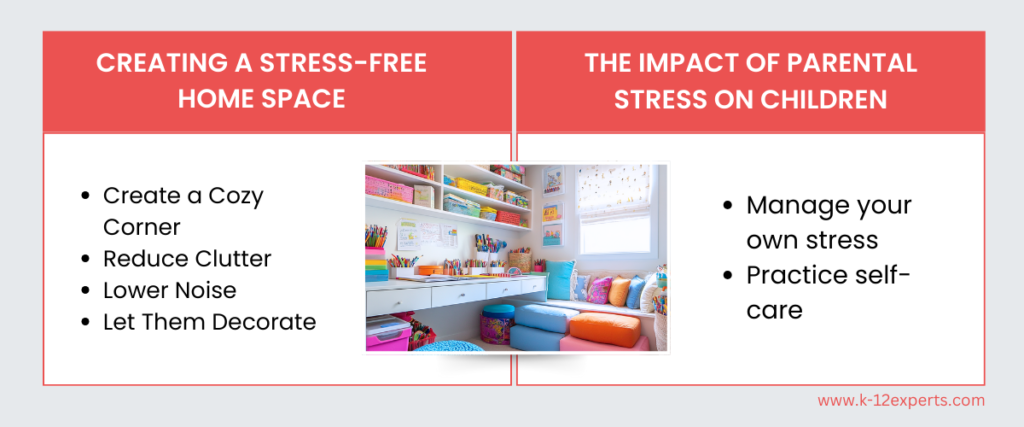
Your home environment can impact your child’s stress levels, and your own stress may also affect them.
Simple changes can create a more relaxing atmosphere, benefiting both you and your child.
For instance, adding plants, creating a quiet reading nook, and using calming colors can make a big difference. Reducing noise and clutter also helps foster a sense of peace.
Creating a Stress-Free Home Space
To create a calming home environment that supports your child’s mental health, consider these steps:
- Create a Cozy Corner: Encourage your child to pick a relaxing spot to unwind.
- Reduce Clutter: Tidy up together and make it a fun activity.
- Lower Noise: Reduce background noise for a more peaceful atmosphere.
- Let Them Decorate: Involve your child in choosing soothing colors and decorations for their space.
These actions help create a calming space and empower your child by giving them a role in shaping their environment.
The Impact of Parental Stress on Children
As you create a calm home, manage your own stress as well.
Children are sensitive to your emotional state, and your stress can increase their anxiety.
Practicing self-care, seeking therapy, or using relaxation techniques like deep breathing or yoga can reduce stress and contribute to a supportive environment for your child.
Conclusion
Think of your home as a nurturing environment where your child can grow emotionally and mentally, just like a young plant in a garden.
Through understanding, support, and practical tools like deep breathing or mindful conversations, you help them thrive even in the face of stress and anxiety.
When challenges become overwhelming, seeking professional help is a smart step to ensure their well-being.
Teaching them to manage stress effectively now lays the foundation for a healthier, happier future and reinforces your commitment to their emotional growth and resilience.
Frequently Asked Questions
Can Changing a Child’s Diet Reduce Their Anxiety?
Adjusting the diet can help reduce anxiety by incorporating foods like omega-3-rich salmon or walnuts, which support brain function and emotional well-being.
Are There Genetic Factors That Contribute to Child Anxiety?
Genetics can play a role in anxiety. Understanding family history allows for early intervention and strategies like mindful breathing and family discussions.
How Does Screen Time Impact a Child’s Stress Levels?
Excessive screen time can increase stress in children. Mixing tech use with physical play is beneficial. Playing outside or engaging in hands-on activities helps relieve stress and promotes overall health. For example, children could play tag or build with blocks instead of watching videos. These activities reduce screen time and promote physical health and social interaction.
Can Pets Help Children Manage Stress and Anxiety?
Having a pet can help children manage stress and anxiety by lifting their spirits, offering comfort, and creating a feeling of friendship. Pets provide unconditional support and can divert a child’s attention from anxieties, contributing to a calmer mindset.
What Role Does Sleep Play in Managing Child Anxiety?
Getting enough sleep is crucial for managing anxiety in children. It helps calm their mind and prepares them to handle stress. To ensure good quality sleep, maintain a consistent bedtime routine, create a quiet and comfortable sleep environment, and limit screen time before bed.

